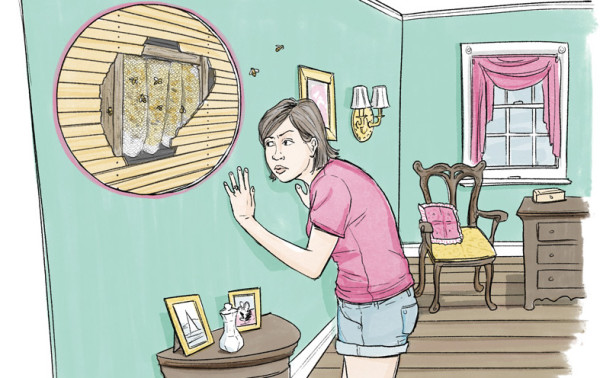This content was originally published on OldHouseOnline.com and has been republished here as part of a merger between our two businesses. All copy is presented here as it originally appeared there.

“Not long after we moved into our 1791 stone farmhouse, we realized we were not alone. A steady hum was coming from deep within our velvet-green living-room walls. Turned out, bees were living in there-thousands of them! We’ve managed to coexist for years. But now they’ve started chasing us down the sidewalk.“ – Deb Botti
THE FIX
Honeybees pollinate up to a third of all food crops, so it’s important not to disturb a healthy colony if you can avoid it. Sometimes you can live with the bees-until you can’t. You might look for a beekeeper willing to take them, but few want to do the messy work given the bee survival rate.
You may be able to relocate the bees by trapping them. Reduce access to the hive to one opening, sealing all other holes ¼“ across or larger. Make a funnel out of insect screening and place the large end of the cone over the hole. Cut a small exit point at the tip of the cone (3/8³ or less across). The bees can exit, but they cannot re-enter. To attract the bees, have a beekeeper set up a small hive with a few frames of brood honey and a queen near the exit cone. With luck, the bees that leave the nest in the wall will join the new hive.
Your carpenter’s proposal-waiting until the bees are dormant, then removing boards for access to the hive-is a good one. Once the weather is chilly, cut off the heat in that part of the house. Remove old clapboards and window framing carefully, so that they can be reinstalled after the bees are gone.
An old hive like yours will likely resemble a long, convoluted sausage running up and down between the wall studs. While an attack is unlikely (the bees will be sleepy and cold), do wear protective clothing: a veiled hat, thick gloves over the ends of a long-sleeved shirt, and long pants tucked tightly into boots. Use a Shop-Vac to suck up errant bees. Remove the hive as gently as possible. Leave the area open for a few days before completing repairs, just in case.







